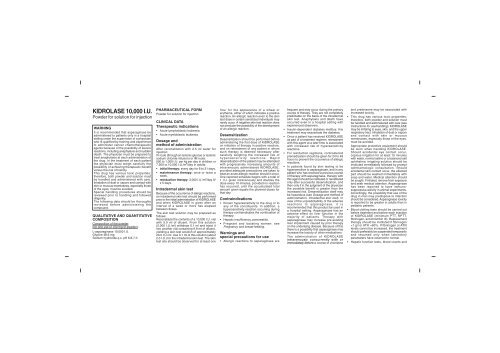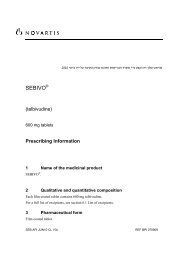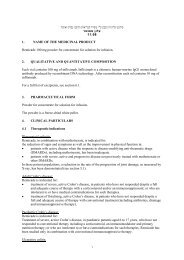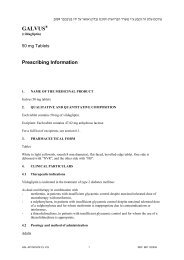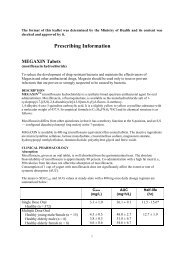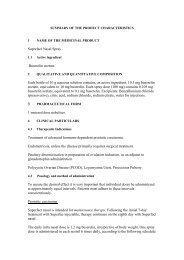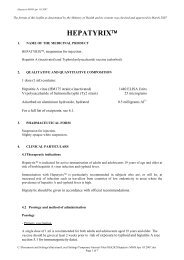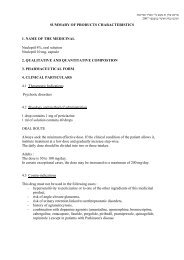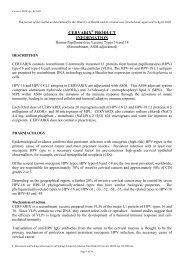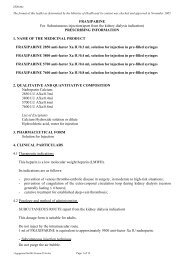KIDROLASE 10,000 I.U.
KIDROLASE 10,000 I.U.
KIDROLASE 10,000 I.U.
Create successful ePaper yourself
Turn your PDF publications into a flip-book with our unique Google optimized e-Paper software.
<strong>KIDROLASE</strong> <strong>10</strong>,<strong>000</strong> I.U.<br />
Powder for solution for injection<br />
WARNING<br />
It is recommended that asparaginase be<br />
administered to patients only in a hospital<br />
setting under the supervision of a physician<br />
who is qualified by training and experience<br />
to administer cancer chemotherapeutic<br />
agents because of the possibility of severe<br />
reactions, including anaphylaxis and sudden<br />
death. The physician must be prepared to<br />
treat anaphylaxis at each administration of<br />
the drug. In the treatment of each patient<br />
the physician must weigh carefully the<br />
possibility of achieving therapeutic benefit<br />
versus the risk of toxicity.<br />
This drug has various toxic properties;<br />
therefore, both powder and solution must<br />
be handled and administered with care.<br />
Inhalation of dust or vapors and contact with<br />
skin or mucous membranes, especially those<br />
of the eyes, must be avoided.<br />
Special handling procedures should be<br />
reviewed prior to handling and followed<br />
diligently.<br />
The following data should be thoroughly<br />
reviewed before administering the<br />
compound.<br />
QUALITATIVE AND QUANTITATIVE<br />
COMPOSITION<br />
Composition of the powder<br />
(for one vial of <strong>10</strong>0 mg of powder):<br />
L-asparaginase <strong>10</strong>,<strong>000</strong> I.U.<br />
Glycine 48.6 mg<br />
Sodium hydroxide q.s. pH 6.8-7.0<br />
PHARMACEUTICAL FORM<br />
Powder for solution for injection.<br />
CLINICAL DATA<br />
Therapeutic indications<br />
• Acute lymphoblastic leukemia<br />
• Acute myeloblastic leukemia<br />
Dosage and<br />
method of administration<br />
After reconstitution with 2.5 ml water for<br />
injection:<br />
IV route (through an isotonic glucose or isotonic<br />
sodium chloride infusion) or IM route:<br />
500 to 1,<strong>000</strong> I.U. per kg per day in children or<br />
7,500 to <strong>10</strong>,<strong>000</strong> I.U./m2 /day in adults:<br />
• initial therapy: every day for 6 to 21 days,<br />
• maintenance therapy: once or twice a<br />
week,<br />
• reinduction therapy: 3,<strong>000</strong> I.U./m2 /day IV<br />
x 5 days.<br />
Intradermal skin test<br />
Because of the occurrence of allergic reactions,<br />
an intradermal skin test should be performed<br />
prior to the initial administration of <strong>KIDROLASE</strong><br />
and when <strong>KIDROLASE</strong> is given after an<br />
interval of a week or more has elapsed<br />
between doses.<br />
The skin test solution may be prepared as<br />
follows:<br />
Reconstitute the contents of a <strong>10</strong>,<strong>000</strong> I.U. vial<br />
with 5.0 ml of diluent. From this solution<br />
(2,<strong>000</strong> I.U./ml) withdraw 0.1 ml and inject it<br />
into another vial containing 9.9 ml of diluent,<br />
yielding a skin test solution of approximately<br />
20.0 I.U./ml. Use 0.1 ml of this solution (about<br />
2.0 I.U.) for the intradermal skin test. The skin<br />
test site should be observed for at least one<br />
hour for the appearance of a wheal or<br />
erythema, either of which indicates a positive<br />
reaction. An allergic reaction even to the skin<br />
test dose in certain sensitized individuals may<br />
rarely occur. A negative skin test reaction does<br />
not preclude the possibility of the development<br />
of an allergic reaction.<br />
Desensitization<br />
Desensitization should be performed before<br />
administering the first dose of <strong>KIDROLASE</strong><br />
on initiation of therapy in positive reactors,<br />
and on retreatment of any patient in whom<br />
such therapy is deemed necessary after<br />
carefully weighing the increased risk of<br />
hypersensitivity reactions. Rapid<br />
desensitization of the patient may be attempted<br />
with progressively increasing amounts of<br />
intravenously administered <strong>KIDROLASE</strong>,<br />
provided adequate precautions are taken to<br />
treat an acute allergic reaction should it occur.<br />
One reported schedule begins with a total of<br />
1 I.U. given intravenously and doubles the<br />
dose every <strong>10</strong> minutes, provided no reaction<br />
has occurred, until the accumulated total<br />
amount given equals the planned doses for<br />
that day.<br />
Contraindications<br />
• Known hypersensitivity to the drug or to<br />
any of the constituents. In addition, a<br />
hypersensitivity reaction occurring during<br />
therapy contraindicates the continuation of<br />
therapy.<br />
• Hepatic insufficiency, pancreatitis.<br />
• Pregnant and lactating women: see<br />
Pregnancy and breast-feeding.<br />
Warnings and<br />
special precautions for use<br />
• Allergic reactions to asparaginase are<br />
frequent and may occur during the primary<br />
course of therapy. They are not completely<br />
predictable on the basis of the intradermal<br />
skin test. Anaphylaxis and death have<br />
occurred even in a hospital setting with<br />
experienced observers.<br />
• Insulin-dependent diabetes mellitus: this<br />
treatment may exacerbate the diabetes.<br />
• Once a patient has received <strong>KIDROLASE</strong><br />
as part of a treatment regimen, retreatment<br />
with this agent at a later time is associated<br />
with increased risk of hypersensitivity<br />
reactions.<br />
• For reinduction regimens, corticosteroid<br />
premedication should be given for 24 to 48<br />
hours to prevent the occurrence of allergic<br />
reactions.<br />
• In patients found by skin testing to be<br />
hypersensitive to asparaginase, and in any<br />
patient who has received a previous course<br />
of therapy with asparaginase, therapy with<br />
this agent should be instituted or reinstituted<br />
only after successful desensitization, and<br />
then only if in the judgment of the physician<br />
the possible benefit is greater than the<br />
increased risk. Desensitization itself may<br />
be hazardous (see Dosage and method of<br />
administration, Intradermal skin test). In<br />
view of the unpredictability of the adverse<br />
reactions to asparaginase, it is<br />
recommended that this product be used in<br />
a hospital setting. Asparaginase has an<br />
adverse effect on liver function in the<br />
majority of patients. Therapy with<br />
asparaginase may increase pre-existing<br />
liver impairment caused by prior therapy<br />
on the underlying disease. Because of this<br />
there is a possibility that asparaginase may<br />
increase the toxicity of other medications.<br />
The administration of <strong>KIDROLASE</strong><br />
intravenously concurrently with or<br />
immediately before a course of vincristine<br />
and prednisone may be associated with<br />
increased toxicity.<br />
• This drug has various toxic properties;<br />
therefore, both powder and solution must<br />
be handled and administered with care (see<br />
Instructions for use/handling). <strong>KIDROLASE</strong><br />
may be irritating to eyes, skin, and the upper<br />
respiratory tract. Inhalation of dust or vapors<br />
and contact with skin or mucous<br />
membranes, especially those of the eyes,<br />
must be avoided.<br />
Appropriate protective equipment should<br />
be worn when handling <strong>KIDROLASE</strong>.<br />
Should accidental eye contact occur,<br />
copious irrigation for at least 15 minutes<br />
with water, normal saline or a balanced salt<br />
ophthalmic irrigating solution should be<br />
instituted immediately followed by prompt<br />
ophthalmologic consultation. Should<br />
accidental skin contact occur, the affected<br />
part should be washed immediately with<br />
soap and water. Medical attention should<br />
be sought. If inhaled, remove from exposure<br />
and seek medical attention. Asparaginase<br />
has been reported to have immunosuppressive<br />
activity in animal experiments.<br />
Accordingly, the possibility that use of the<br />
drug in man may predispose to infection<br />
should be considered. Asparaginase toxicity<br />
is reported to be greater in adults than in<br />
pediatric patients.<br />
• Blood clotting tests should be carried out<br />
before treatment and before each injection<br />
of <strong>KIDROLASE</strong> (minimum PTT, KPTT,<br />
fibrinogen, anti-thrombin III). Replacement<br />
therapy should be instituted if fibrinogen<br />
one marrow tests should be monitored<br />
regularly during therapy.<br />
• Glycemia and amylasemia should be<br />
monitored all along therapy. The treatment<br />
should be withdrawn in case amylasemia<br />
level increases.<br />
• Patients should be monitored to detect and<br />
prevent cytolysis which can lead to<br />
hyperuricemia.<br />
Interactions with other drugs and<br />
other forms of interaction<br />
Associations to be taken into<br />
consideration<br />
Attenuated live vaccines: risk of possibly fatal<br />
disseminated disease. This is even more likely<br />
to occur in subjects already<br />
immunosuppressed by the underlying disease.<br />
Use an inactivated vaccine when available<br />
(poliomyelitis).<br />
Drug interactions<br />
Tissue culture and animal studies indicate that<br />
asparaginase can diminish or abolish the effect<br />
of methotrexate on malignant cells. This effect<br />
on methotrexate activity persists as long as<br />
plasma asparagine levels are suppressed.<br />
These results would seem to dictate against<br />
the clinical use of methotrexate with<br />
asparaginase, or during the period following<br />
asparaginase therapy when plasma asparagine<br />
levels are below normal.<br />
Drug/laboratory test interactions<br />
L-asparaginase has been reported to interfere<br />
with the interpretation of thyroid function tests<br />
by producing a rapid and marked reduction in<br />
serum concentrations of thyroxine-binding<br />
globulin within two days after the first dose.<br />
Serum concentrations of thyroxine-binding<br />
globulin returned to pretreatment values within<br />
four weeks of the last administration of<br />
L-asparaginase.<br />
Pregnancy and breast-feeding<br />
This drug is contraindicated during pregnancy<br />
and for nursing mothers.<br />
Pediatric use<br />
Asparaginase toxicity is reported to be greater<br />
in adults than in pediatric patients.<br />
Adverse effects<br />
Hypersensitivity is the most frequent adverse<br />
reaction, such as urticaria, edema of the larynx,<br />
bronchospasm, hypotension or even true<br />
anaphylactic shock. If these reactions occur,<br />
the treatment should be discontinued<br />
immediately and withdrawn (see<br />
Contraindications).<br />
• In pediatric patients with advanced<br />
leukemia, a lower incidence of anaphylaxis<br />
has been reported with intramuscular<br />
administration, although there was a higher<br />
incidence of milder hypersensitivity reactions<br />
than with intravenous administration.<br />
• Fatal hyperthermia has been reported.<br />
Inhibition of protein synthesis:<br />
• Clotting disorders including increased PT<br />
and thromboplastin time with<br />
•<br />
hypofibrinogenemia, decrease in antithrombin<br />
III, plasminogen and other factors<br />
(VII, IX, X and VIII), leading to possible<br />
bleeding and thrombotic complications:<br />
Decrease in serum insulin with<br />
hyperglycemia; glucosuria and polyuria.<br />
• Inhibition of lipoprotein lipase activity;<br />
increase in serum triglycerides and<br />
cholesterol.<br />
• Decrease in brain concentrations of<br />
L-asparagine or L-glutamine, resulting in<br />
hyperammonemia with clinical signs of<br />
metabolic encephalopathy such as<br />
consciousness disorders with confusion,<br />
stupor or coma in some patients.<br />
Some patients have shown central nervous<br />
system effects consisting of depression,<br />
somnolence, fatigue, coma, confusion,<br />
agitation and hallucinations varying from mild<br />
to severe. Rarely, a Parkinson-like syndrome<br />
has occurred, with tremor and a progressive<br />
increase in muscular tone. These side effects<br />
usually have reversed spontaneously after<br />
treatment was stopped. Therapy with<br />
asparaginase is associated with an increase<br />
in blood ammonia during the conversion of<br />
asparagine to aspartic acid by the enzyme.<br />
No clear correlation exists between the degree<br />
of elevation of blood ammonia levels and the<br />
appearance of CNS changes.<br />
Other adverse effects:<br />
• Acute pancreatitis, including fatalities.<br />
• Cholestatic or hepatocellular liver injury with<br />
or without steatosis.<br />
• A variety of liver function abnormalities have<br />
been reported, including elevations of<br />
SGOT, SGTP, alkaline phosphatase,<br />
bilirubin (direct and indirect), and depression<br />
of serum albumin, cholesterol (total and<br />
esters), and plasma fibrinogen. Increases<br />
and decreases of total lipids have occurred.<br />
Marked hypoalbuminemia associated with<br />
peripheral edema has been reported.<br />
However, these abnormalities usually are<br />
reversible on discontinuance of therapy and<br />
some reversal may occur during the course<br />
of therapy. Fatty changes in the liver have<br />
been documented by biopsy. Malabsorption<br />
syndrome has been reported.<br />
• Rarely, transient bone marrow depression<br />
has been observed, as evidenced by a<br />
delay in return of hemoglobin or hematocrit<br />
levels to normal in patients undergoing<br />
hematologic remission of leukemia.<br />
• Marked leukopenia has been reported.<br />
• Nausea, vomiting, chills, fever, anorexia,<br />
abdominal cramps, weight loss.<br />
• Amenorrhea, azoospermia.<br />
• Headache and irritability may occur and<br />
usually are mild.<br />
• Azotemia, usually pre-renal, occurs<br />
frequently. Acute renal shut down and fatal<br />
renal insufficiency have been reported<br />
during treatment. Proteinuria has occurred<br />
infrequently.<br />
Overdosage<br />
The acute intravenous LD 50 of asparaginase<br />
for mice was about 500,<strong>000</strong> I.U./kg and for<br />
rabbits about 22,<strong>000</strong> I.U./kg.<br />
PHARMACOLOGICAL PROPERTIES<br />
Pharmacodynamic properties<br />
OTHER ANTINEOPLASTICS<br />
(L: Antineoplastics and immunomodulators)<br />
L-asparaginase is a protein enzyme extracted<br />
from Escherichia coli which degrades<br />
asparagine by hydrolysis.<br />
This amino acid is one of the basic constituents<br />
of cellular protein. As leukemic cells cannot<br />
synthesize asparagine endogenously, they<br />
are dependent on an exogenous source of<br />
asparagine for survival. Depletion of<br />
asparagine by treatment with L-asparaginase<br />
results in the death of cells unable to synthesize<br />
asparagine endogenously. Due to this special<br />
mechanism of action, cross-resistance with<br />
other cytostatic agents is not observed.<br />
Pharmacokinetic properties<br />
Tissue diffusion of L-asparaginase is low. It<br />
has a biphasic half-life ranging from 8 to 30<br />
hours according to subject. 24 hours after an<br />
IV dose of 1,<strong>000</strong> I.U./kg, plasma concentrations<br />
were 8 to 20 I.U./ml, while plasma<br />
concentrations after an IM injection were 50%<br />
lower.<br />
PHARMACEUTICAL DATA<br />
Shelf-life<br />
Before reconstitution: 2 years.<br />
After reconstitution: see Special precautions<br />
for storage.<br />
Special precautions for storage<br />
Before reconstitution: store at a temperature<br />
between 2°C and 8°C.<br />
After reconstitution: the reconstituted solution<br />
may be kept for 24 hours at a temperature<br />
between 2°C and 8°C.<br />
Instructions for use/handling<br />
This drug must be handled and prepared with<br />
caution. The use of gloves, safety glasses and<br />
a mask is recommended.<br />
In case of contact of the solution for dilution<br />
or the infusion solution with the skin, wash<br />
immediately and thoroughly with soap and<br />
water.<br />
In case of contact of the solution for dilution<br />
or the infusion solution with mucous<br />
membranes, wash immediately with copious<br />
amounts of water.<br />
Do not mix with other drugs.<br />
Manufacturer<br />
OPi S.A., France.<br />
Importer<br />
CTS Ltd.,<br />
4 Haharash Street, Hod Hasharon.<br />
SH 0905


